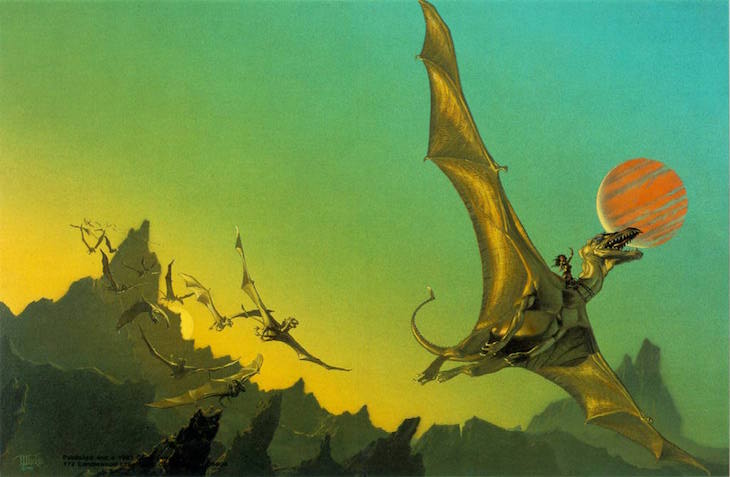
Dragonflight (Pern: Dragonriders of Pern, #1)
Written by Anne McCaffrey; First Edition 1979
Published by Del Rey Books
Dragonflight, Anne McCaffrey’s first novel of her fantastically successful Dragonriders of Pern series, introduces us to the world of Pern and to Lessa and F’lar, the hero and heroine.
Pern is the planet of a far-off star, plagued by a sister planet whose orbit sometimes passes close enough to launch nefarious Threads (science-y spore-type life forms which attach and burrow themselves to Pern’s ground and devour plant life). It has been so long since the last attack of Threads that most people no longer believe they exist. The planet has settled into those human goals of acquiring wealth and being the best at politics.
Lessa is the last surviving member of her family, the traditional owners of Ruatha Hold, which has been seized by the warlord Fax. He is a singularly unimpressive as a character—he reads like one of the more predictably misogynistic landowners written by George R.R. Martin. I spent a few terrifying pages wondering if the plot was going to be about F’lar, our hero dragonrider, and Fax trying to out-posture each other. Happily, Fax gets a knife in the back quite early on, thanks in large part to Lessa’s clever manipulation.
I kept reading because of Lessa. She is powerful, she is angry, she is cunning and manipulative. Everyone knows about the deplorable history of women in the sci-fi/fantasy tradition. Lessa, by contrast, uses her magic and her sheer force of will to get what she wants. And in a happy turn of fate, the text does not punish Lessa for her desire for power. Rather, her strength brings her to greater power. The political partnership between Lessa and F’lar is what makes the novel interesting to me—and worth recommending. It is based first on mutual respect for one another’s power and abilities—the romance between them is not fully introduced until long after this is established, and even then it’s understated. A bit too understated, because there were times when their relationship itself was clear, but how they felt about that relationship was not. F’lar also falls back on some disturbing strong-man habits in his relationship with Lessa, including shaking her when he gets upset. Not cool. Despite this, I very much appreciated that Dragonflight is Lessa’s story, taking her from a bitter, angry girl hiding amongst the servants in her ancestral home to queen of all the dragons in her world. Her investment in politics and her rise to power also reminded me of George R.R. Martin, to the point that I wonder if he considers McCaffrey an influence.
The problems in Dragonflight, which are not major, really stem from McCaffrey’s not having reached her full maturity as a writer. Dragonflight was originally published as three separate stories, which contributes to an episodic reading experience. The conflict resolutions are also a bit obvious, and I’m not a huge fan of the time-travel element, which felt derivative. But the intense world-building makes up for it. The only lasting problem I had with the novel is F’lar’s inconsistency. As a leader he is subtle and sophisticated. As a lover he is inconsiderate and selfish.
Final Verdict: Despite the drawbacks I enjoyed Dragonflight, and now have a better understanding of its lasting popularity.